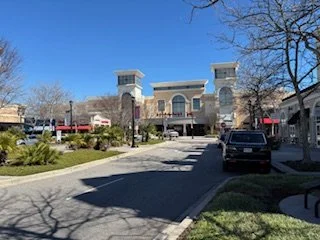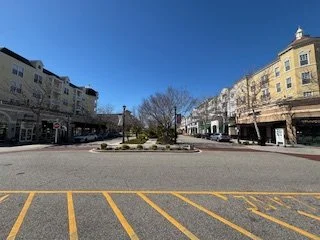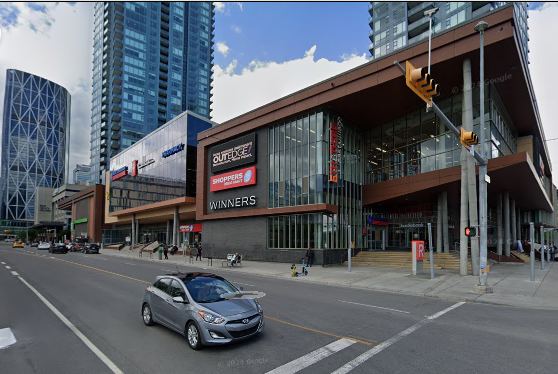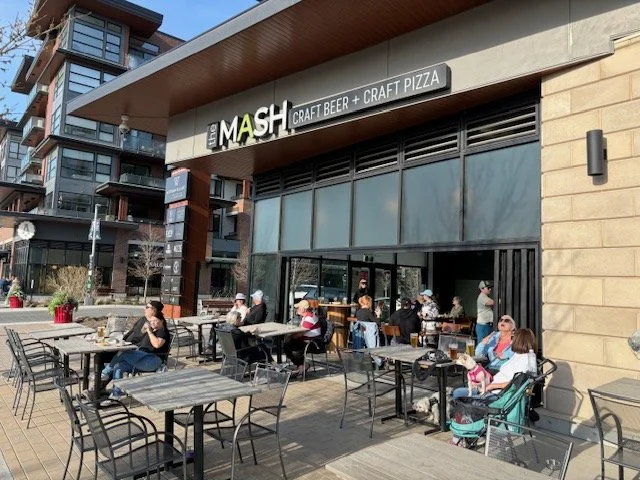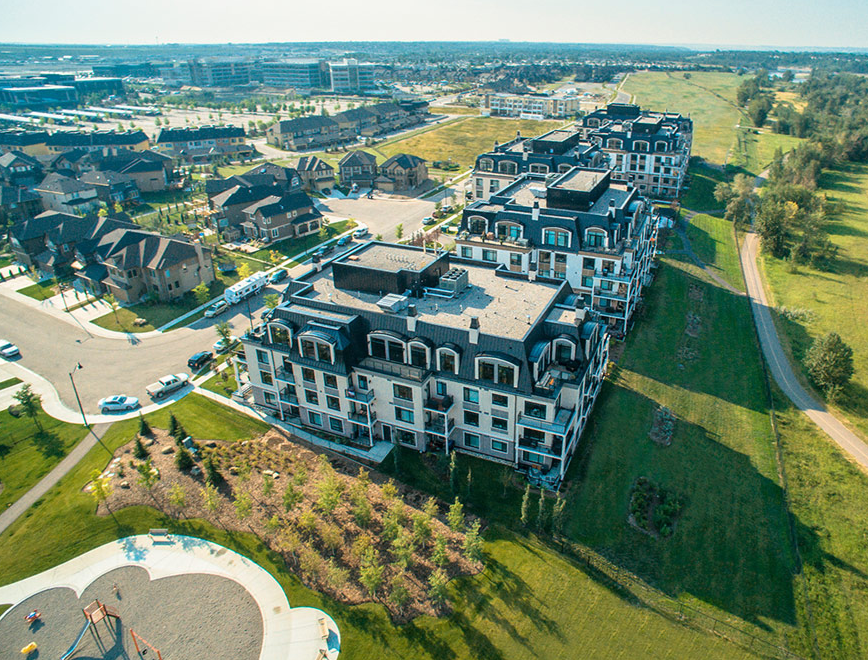Calgary vs Myrtle Beach: New Urban Villages
Market Commons in Myrtle Beach has a very suburban feel with its wide streets and low density development. It doesn’t really feel walkable.
In the late 20th century, urban planners and developers were searching for new approaches for creating suburban communities that were more walkable i.e. office, retail and restaurant spaces, as well as parks, playgrounds, schools and other amenities strategically integrated next to a diversity of housing options. The term “urban village” and “lifestyle centres” started to pop-up in planning jargon.
It was a move away from building power centres and regional malls towards creating a modern traditional main street with retail and restaurants along the street and residential above. The model also called for a central park as the gathering place for the community and placing the parking underground or in a parkade, rather than a sea of surface parking. As well, the residential development was more diverse integrating single-family homes with lane houses, row housing and apartments ranging from 4 to 10+ storeys.
Market Common, Myrtle Beach
This past winter I had an opportunity to visit Market Commons in Mrytle Beach (a former Air Force Base which closed in 1993) and compare it with some of Calgary’s new “urban villages.”
The Base’s airport is now the Myrtle Beach International Airport and the Base’s golf course is the city-owned Whispering Pines Golf Course (it was Myrtle Beach’s first golf course, opening in 1927). “Market Commons” is a 114-acre, mixed-use new community anchored by a main-street with retail, restaurants and entertainment on the ground floor and residential above.
However, unlike a traditional main street (with lots of little “mom & pop shops” along the street) Market Commons’ main street buildings have just one major anchor tenant e.g. Pottery Barn or Barnes & Noble so there isn’t the street ballet of people popping in and out of various shops associated with mid-century main streets. We visited on a sunny Saturday in February and the streets were deserted. There was no urban vibe. Why? I suspect it is because it lacks the charm of a traditional main street with its diversity of building shapes and sizes and funky blade signs over the doors. Instead, the homogenous beige architecture and wide boulevard streets make for a rather sterile sense of place.
My disappointment was perhaps amplified as we were staying in nearby Conway with its charming downtown streets that reminded me of Calgary’s Kensington Village or Inglewood’s funky main street.
Typical Market Commons block with single major retailer on the street and residential above.
Calgary’s Urban Villages
University District’s grocery store is nicely integrated into the streetscape, creating a pedestrian friendly experience.
Calgary has been a leader in creating master planned urban villages which started with McKenzie Towne and Garrison Woods in the ‘90s. In the early 20th century, Calgary developers created eight new “urban villages” – Bridges, Currie, East Village, Quarry Park, SETON, University District, West District and Westman Village.
Each of Calgary’s urban villages are unique. East Village is more urban with its taller residential towers and no traditional main street. University District and West District both have a traditional main street with a variety of small shops on both sides of the street residential above. Both have a grocery store as an anchor, integrated into a residential building. Their main streets are surrounded mostly by 6 to 8 floor apartment blocks and townhomes, but with taller residential buildings in the planning stages. They also both have central parks designed to support a diversity of activities and events.
University District’s Main Street has wide sidewalk for pedestrians with lots of shops, restaurants and even a grocery store integrated into the base of a residential building. Good main streets are narrow enough that pedestrians can see the shops on the other side. Note: many of the buildings have a brick facade and are human scale (under 8 stories).
Calgary’s East Village’s grocery store, drug store and retail outlets don’t create a pedestian- friendly main street experience.
Westman Village is a mid-rise village with a one-block long main street and a private recreation centre as its hub. Like East Village’s Riverwalk along the Bow River, it has a popular mixed-use pathway along Mahogany Lake.
Westman Village on the southeast edge of the city has an urban vibe.
SETON (which stands for “southeast town”) is unique in having a regional hospital as its anchor. It also boasts a mega regional recreation centre and high school, with power centre big box retail and surface parking surrounded by huge “horizontal” apartment blocks.
As for Quarry Park, it is a bit of hybrid of old and new suburban community plan thinking as it integrates a central retail mall with surface parking, with a major suburban office park with a combination of surface and underground parking. The commercial development is surrounded by low rise apartment blocks, row and single family housing. It too has its own recreation centre with a library. This walkable community with access to the Bow River as well as internal canals.
Quarry Park is a mix of single family homes with mid-rise apartment blocks, a suburban office park, with commercial core, anchored by a grocery store, as well as recreation centre and school next to the Bow River.
Need better “Main Streets”
The key to a vibrant urban village is it’s main street. While developers and urban planners try to create new communities that are charming with a bit of nostalgia mixed in with modern amenities too often, they fail. I can’t help but wonder why they can’t figure out how to create a good main street with a mix of street retail in pedestrian-friendly buildings. For example, East Village’s highrise towers are not pedestrian friendly. Sidewalks must be wide enough to accommodate groups of people walking along the street, as well as outdoor patios and sidewalk displays. The main street must also be oriented to sun as much as possible. Sun on the sidewalk is critical to creating a successful main street in Calgary (and for any northern city for that matter).
Kudos to University District who used Kensington Village as its model to curate an interesting mix of shops and restaurants with a full-size grocery store with 50+ small shops that includes everything from a bakery to fine dining, from florist to dentist. While the shopkeepers no longer live above their shops, there are literally hundreds of potential customers who do. Perhaps East Village’s master plans biggest mistake is the lack of a traditional linear main street.
Calgary’s Kensington Village establish in the early 20th century was the model for University District’s Main Street created in the early 21st century.
Great main streets have several buildings on each block, each with its own architectural elements, each with great windows for displaying product and each with colourful signage that is fun and folksy. If each block looks the same, it gets boring very quickly.
And nothing beats brick for creating an immediate timeless and charming sense of place.
Last Word
I often wonder why more architects, new community planners and developers haven’t learned this lesson and created smaller buildings with brick facades at street level along their main streets, with the taller residential set back from the street.
Note: An edited version of the blog was published in the Calgary Herald’s New Homes + Condos section on June 25, 2025.

